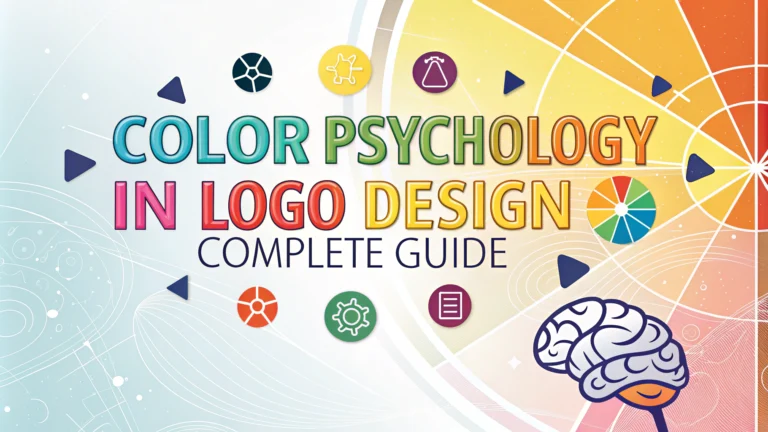Color choices in logo design can make the difference between a memorable brand identity and one that falls flat.
Understanding Color Psychology
Red triggers excitement and passion, making it perfect for brands wanting to convey energy or urgency.
Blue represents trust and reliability, explaining why many financial institutions and tech companies favor this color.
Green connects with nature, growth, and health, making it an excellent choice for environmental or wellness brands.
Yellow radiates optimism and warmth, though it should be used carefully as it can strain eyes when overused.
Color Combinations in Logo Design
- Monochromatic: Different shades of one color create elegant, unified looks
- Complementary: Opposite colors on the color wheel create high contrast and visual impact
- Analogous: Colors next to each other on the wheel offer harmony and balance
- Triadic: Three evenly spaced colors provide vibrant, balanced designs
Industry-Specific Color Guidelines
| Industry | Recommended Colors | Why It Works |
|---|---|---|
| Technology | Blue, Gray, White | Projects reliability and innovation |
| Food | Red, Yellow, Green | Stimulates appetite and energy |
| Healthcare | Blue, Green, White | Creates sense of calm and cleanliness |
Practical Tips for Color Selection
- Test your logo in both color and black/white versions
- Consider color blindness – approximately 8% of males have some form of color vision deficiency
- Check how colors display across different devices and printing methods
- Limit your palette to 2-3 colors for maximum impact
Common Color Mistakes to Avoid
- Using too many colors, which can create visual confusion
- Picking colors based on personal preference rather than brand strategy
- Ignoring color contrast guidelines for accessibility
- Not researching cultural color associations for global brands
For professional color consulting, contact the Color Marketing Group at colormarketing.org.
Tools for Color Selection
- Adobe Color – Create color schemes and test accessibility
- Coolors – Generate color palettes instantly
- Paletton – Advanced color scheme designer
Remember to document your final color choices using both RGB and CMYK values for consistent reproduction across all media.
Design Trends and Future Considerations
Color trends in logo design continue to evolve with changing consumer preferences and technological capabilities. Gradient colors and color transitions are gaining popularity, while minimalist approaches using single colors remain strong.
Emerging Color Trends
- Muted pastels for sophisticated brand identities
- Gradients that combine multiple brand colors
- Dark mode optimization for digital applications
- Nature-inspired color palettes
Digital Considerations
Modern logos must perform well across various digital platforms while maintaining their impact in traditional media.
- Ensure colors are web-safe and responsive
- Consider social media platform requirements
- Test colors across different screen sizes
- Maintain color consistency across digital ecosystems
Cultural Impact on Color Selection
| Culture | Color | Meaning |
|---|---|---|
| Western | White | Purity, cleanliness |
| Eastern | White | Mourning, death |
| Middle Eastern | Green | Sacred, prosperity |
Conclusion
Successful logo color selection requires careful consideration of psychology, industry standards, and practical applications. While trends may influence choices, the focus should remain on creating timeless designs that effectively communicate brand values and resonate with target audiences.
Regular color audits and updates ensure logos remain relevant while maintaining brand recognition. Document all color decisions and maintain strict guidelines for consistent implementation across all brand touchpoints.
FAQs
- How does color psychology affect brand perception in logo design?
Color psychology influences how consumers perceive and interact with a brand. Red can evoke excitement and passion, blue suggests trust and reliability, yellow represents optimism and energy, while green often symbolizes growth and nature. - What colors work best for financial or banking logos?
Blue is predominantly used in financial sector logos because it conveys trustworthiness, stability, and professionalism. Dark blues especially communicate security and dependability, which are crucial for financial institutions. - Should I use multiple colors in my logo design?
While multicolor logos can be effective, it’s generally recommended to limit your palette to 2-3 colors for better recognition and reproduction across different mediums. Too many colors can complicate the design and increase printing costs. - What color combinations should be avoided in logo design?
Avoid combinations that create visual vibration (like red and blue directly adjacent) or colors with similar values that don’t provide enough contrast. Also avoid using colors that are commonly associated with competitors in your industry. - How do different cultures interpret colors in logos?
Color meanings vary significantly across cultures. For example, white symbolizes purity in Western cultures but represents mourning in many Eastern cultures. Red means luck in Chinese culture but can signify danger in Western contexts. - What is the importance of color consistency in logo design?
Maintaining consistent colors across all brand touchpoints is crucial for brand recognition. This requires proper color specification using Pantone, CMYK, and RGB values to ensure consistency across different mediums. - How do colors affect logo visibility and legibility?
High contrast between colors improves logo visibility and readability. Dark colors on light backgrounds or vice versa typically work best. Consider how the logo will appear in both digital and print formats. - What colors are trending in modern logo design?
Gradients, muted tones, and minimalist color palettes are currently trending. Companies are also embracing bold, vibrant colors and unexpected color combinations to stand out in digital environments. - Should my logo work in black and white?
Yes, a well-designed logo should be effective in both color and monochrome versions. This ensures versatility across different applications and maintains recognition when color reproduction isn’t possible. - How do colors in logos affect customer behavior?
Colors can influence purchasing decisions and brand engagement. Research shows that up to 85% of consumers cite color as a primary reason for buying a product, and color can increase brand recognition by up to 80%.







